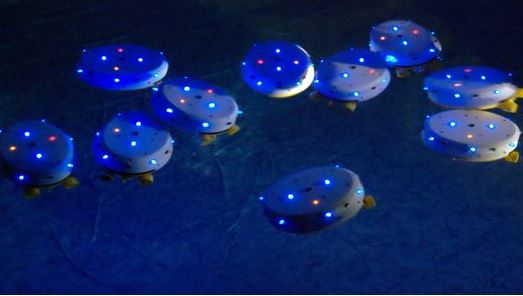For the past four years the European Union CoCoRo (Collective Cognitive Robots) research consortium has been developing a variety of autonomous underwater robots that school together like fish. The tiny bots are able to share and learn from each others’ knowledge of their surroundings, acting as a collective cognitive system that’s smarter than any one of its individual parts.
How does this work? The robots communicate with one another via built-in flashing LEDs, using onboard electronics including computer vision systems, compasses, and accelerometers to find their way around aquatic environments. Utilizing an algorithm that was inspired by the clustering nature of bees (not fish), they’re able to seek out others of their kind and then settle together around one central base location, becoming aware of the growing size of their group as more robots join in. Individuals can leave the cluster to go on their own missions, and return to share their findings with the group.

A group of underwater robots. Image via Gizmag.
One experiment consisted of two groups of robots – “Jeff” robots and “Lily” robots – which were put in a pool to locate a simulated crashed airplane (which actually were a group of magnets used to simulate the plane’s electro-magnetic field). As the Lily robots patrolled the surface, the Jeffs dove deep. Once one of the Jeff robots located the magnets, it used its LEDs to signal the other Jeffs, which gathered around it over the “wreckage.” From up above, the Lily bots observed the behavior and responded by forming a cluster on the surface in the same location.
Both the Jeff and Lily robots have also been tested in the open ocean in Italy, where they were able to cluster and patrol, despite the waves, currents, and salt water.
Even though the CoCoRo project finished up last September, the researchers are now beginning to publicize the results. The purpose behind the project is to someday have the technology find its way into autonomous schooling aquatic robots used for ecological monitoring, reconnaissance, and other applications.
Story via Gizmag.
Advertisement
Learn more about Electronic Products Magazine





